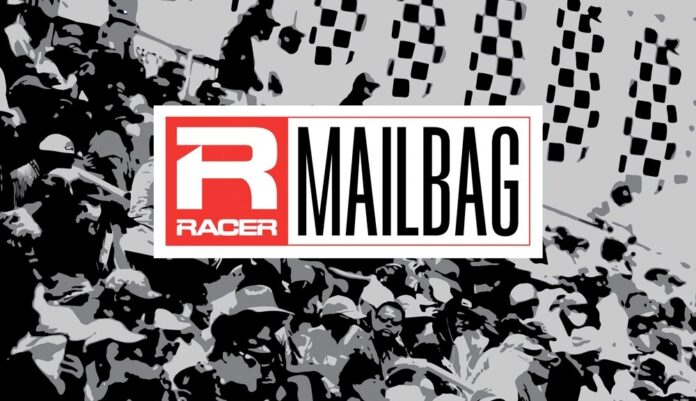Welcome to the RACER Mailbag. Questions for any of RACER’s writers can be sent to mailbag@racer.com. Due to the high volume of questions received, we can’t guarantee that every letter will be published, but we’ll answer as many as we can. Published questions may be edited for length and clarity. Questions received after 3pm ET each Monday will appear the following week.
Q: Any ‘Travis Pastrana to run the Indy 500’ rumors, fresh from his Daytona one-off?
Shawn, MD
MARSHALL PRUETT: Not that I’ve heard of or would expect. I know Travis was in the mix as a possible driver during the ill-fated 2011 Las Vegas $1 million IndyCar race, but since then, with all of the broken bones and concussions and other maladies, he seemed to be super-content with completing his first and last Daytona 500. And to be fair to him, it would take a good while to master an IndyCar on an oval at 235mph. I’m not saying a Cup car is a piece of cake, but attempting something at the Indy 500 as someone who hasn’t done a lot of oval racing in recent years would be wildly ambitious.
Q: All the discussion about not getting the 2.4L and going hybrid got me thinking about how IndyCar ended up with a 2.2L V6 in the first place. I realize small displacement, high strung engines have been popular in circuit racing, but it seems like auto manufacturers have concluded that 500 cc’s per cylinder is the ideal size with an under square bore. There are two-liter inline fours and three-liter inline sixes everywhere, and has been for a long time. That can’t be by chance and must have an optimal combustion chamber design and the lowest possible friction loss.
For a little extra power/torque some bump up the displacement. Ford has the 2.3L turbo inline four and Chevy has the turbo 2.7L inline four, for instance. Chrysler now has an awesome twin turbo 3L inline six and Mazda just came out with a 3.3L. What factors drove IndyCar to settle on a small V6 over an inline four of the same size or a larger straight six? To be clear I’m not advocating for a four-cylinder, but a straight six would be cool. Minus the extra length I don’t see any downsides. It should be better balanced, lighter, and have less parts. Wouldn’t the manufacturers want this?
Dave from MN
MP: IndyCar spoke with the interested auto manufacturers back in 2010 as the new chassis and engine formulas were being developed, and actually, the original plan for the turbo V6 formula was 2.4 liters, but soon after that was announced, it was reduced to 2.2 liters as the slightly smaller displacement was seen as better for marketing and as a better number that fit the production car offerings they had.
The turbo V6 formula also called for identical mounting points for all engines, and did not allow for anything other than six cylinders in a V configuration, so that ended any thoughts of inline, boxer, or rotary motors. These are all items that Chevy, Honda, and Lotus agreed to and, in some cases, heavily steered, so there was buy-in from start to finish on the formula we have today being what it is.
Q: Have you heard any talk about possibly outlawing the ‘dragon’ move that Marcus Ericsson and Simon Pagenaud used at Indy in recent years?
I recall several drivers saying they thought it might be impossible to beat after last years’ race.
Stu
MP: I can only hope it will be resigned to history going forward as I hated it the first time I saw it done to that degree with Simon, but after asking the series whether it will be outlawed, I’m told there are no changes to ban the weaving and blocking coming in May.

IndyCar has no plans to slay the dragon at Indy anytime soon. Jake Galstad/Motorsport Images
Q: Any chance we’ll get the LED panels back with the driver’s name prominently displayed? And perhaps, wait for it, use them as a billboard to promote the series and add the money saved to the Leaders Circle pot?
Peter Carey, San Bruno, CA
MP: Bless you, Peter. Unlikely before we go to a new chassis in 2057. What if we asked IndyCar to mandate the installation of a small vertical piece of pipe on top of the roll hoops so teams could install those big poles with flags like you see in truck beds of the support vehicles at NASCAR races, but the flags would have the drivers’ faces and numbers and names on them? I think we have a non-LED winner here. And if every car was required to carry them, each car would carry the same aerodynamic disadvantage, so it would be a wash. Make it so, Jay Frye!
Q: Being a SoCal native who has seen the rise and fall of numerous race tracks throughout my racing lifetime, what’s your valued take on what’s next at Auto Club Speedway? The future with our venue is as tight-lipped as it comes. Any insight here is highly appreciated.
Denny Valdez
MP: I know next to nothing, other than what I learned in a video today where it was said the track won’t be on NASCAR’s 2024 calendar as its revisions — whatever they end up being — wouldn’t be completed in time for Cup to return and race next year. I’ll be honest; it’s not a track I’ve heard of in relation to IndyCar making a future return, so with that in mind, I haven’t paid too much attention.
The one track that I have heard of as a possible venue for IndyCar, although it’s said to be slim odds, is good old Circuit Gilles Villeneuve in Canada. I haven’t been there in forever — the 2000 Formula 1 race, I think, where I was engineering an Atlantic car — and would love for us to add a second stop north of the border.
Q: This is quote from another publication concerning F1: “We will never go electric,” said Stefano Domenicali in an interview with Italy’s Il Sore 24 Ore. Instead, the Italian said that F1 will hedge its future on a “clean, zero-emission petrol” that it is reportedly developing for an anticipated 2026 rollout”. To me, this appears to be a very short-sighted way to look at the future, I would hope IndyCar looks at this as an opportunity to knock F1 down a notch or two.
Mike, Chicago
MP: Echoing what we’ve written a few times recently, I’d look for IndyCar to do as its auto manufacturers call for in the future, and like Domenicali, I don’t expect IndyCar to go all-electric anytime soon. General Motors has targeted 2035 for being fully electric, so what does that mean for IndyCar? If Chevy’s still involved, I’d imagine some hard conversations about what would be relevant for them to race will be front and center. If GM no longer sells vehicles with internal combustion engines, why would it spend tons of money to compete with an ICE in IndyCar, or any other series?
Dumb of Domenicali to say ‘never,’ but he clearly can’t see a future where the ICE isn’t involved. I don’t want to see the ICE disappear in IndyCar, ever, but it would be silly to say ‘never’ when we don’t know what the automotive world will look like 10 or 15 years from now.



